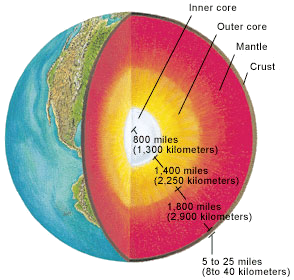
NASA; Public Domain The Earth is like an onion; it has layers! This activity will show you what the inside of the Earth looks like. Look below for step by step instructions with pictures! You will need:

Florissant Fossil Beds National Monument InstructionsStep One:Roll a small ball (about the size of a gumball) of each color of play dough. The yellow ball can be slightly smaller than the rest. Step Two:Take the small ball of yellow play dough and put it in the center of your plate. 
Florissant Fossil Beds National Monument Step Three:Take the ball of orange play dough and flatten it on top of the yellow ball so that the yellow is completely covered. The whole ball should look like it is orange with no yellow showing. Step Four:Flatten the red ball and wrap it around the orange like you did in step three. Make sure there is no orange showing now. 
Florissant Fossil Beds National Monument Step Five:Flatten the green ball and cover the red with it. Step Six:Flatten the blue ball and wrap it around the green.This color represents the atmosphere, which is made of gasses making it the least dense and outermost layer that makes up the Earth. 
Florissant Fossil Beds National Monument Step Seven (Optional):If you’d like, you can put some bits green on top of the blue to represent the visible parts of the crust. If you have white you could also put some bits of white as well to represent clouds in the atmosphere. 
Florissant Fossil Beds National Monument Step Eight:Put your play dough model of Earth on the paper plate. Use the plastic knife to carefully cut the play dough ball in half and look at the inside of it. You should see the different layers of color. This is what a cross section of the planet Earth would look like. Can you make comparisons between your model of Earth and the diagram? 
Florissant Fossil Beds National Monument Step Nine:Lay one half of the model on the plate with the flat part down. Take the straw and push it through the center. Pull the straw through so you can look at it. There should be play dough stuck inside the straw.
Florissant Fossil Beds National Monument You are looking at a “core” sample of what the Earth looks like. Geologists will take core samples to look at rocks that they can’t see on the surface. New Words!
|
Last updated: August 16, 2022
